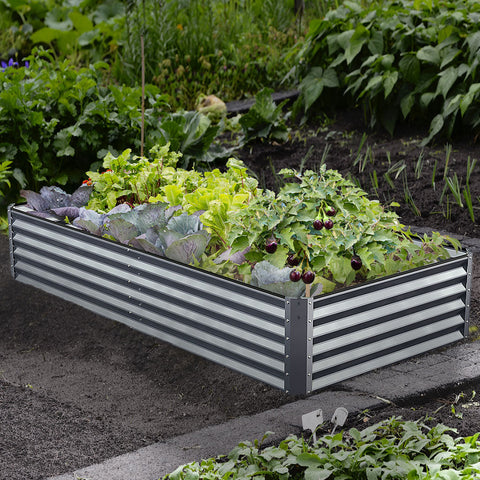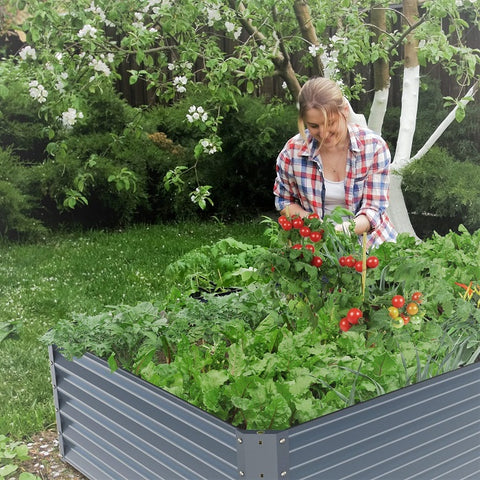Growing your own vegetables and herbs can be fun and rewarding, but sometimes it can go wrong. Here are common mistakes you should avoid and how to correct them. The following content also has some reference value for raised garden beds.
Whether you've been a gardener for two days or 20 years, mistakes are sometimes inevitable. However, some problems can easily be avoided. Take the time to figure out how to avoid these problems, and this year's harvest may be your best.
Mistake # 1: Planting too early
When spring finally arrives, most people are eager to get back into the garden. But if you live where it could still be below freezing, skip tender crops like tomatoes, cucumbers, melons, eggplants and peppers. The vegetables should be kept under the covers until overnight temperatures remain at least 55 degrees Fahrenheit. If you want to give them a head start, plant them under a growing cloth, clock, milk jug, or other type of protection.
Mistake # 2: Crowding plants together
Some salad crops, such as spinach, pine leaf lettuce, arugula, and kale, don't mind growing side by side. However, most vegetables are best not packed too tightly. Tomatoes, for example, need good air circulation to stay healthy, so make sure they are at least 2-3 feet apart. If they are planted too closely, they are more likely to develop problems, such as blight or mold. Other vegetables that need more breathing room include broccoli, cauliflower, eggplant, sweet corn, potatoes and peppers.

Mistake No. 3: Watering too much or too little
Continuous watering is essential to a good harvest. Most crops will do just fine with an inch or so of moisture per week. Buy a rain gauge to monitor rainfall and use a drip irrigation system or soaking hose to make up for dry periods. Plants deprived of water will show marked signs of wilting and yellowing of leaves, and fruit will be stunted or deformed. Vegetables with too much water usually won't be a problem as long as the soil drains well, but melons and tomatoes can crack if watered inconsistently. If there is too much water in the garden, your crops will suffer and the leaves will turn yellow. The only way to solve this problem is to improve the soil by adding a few inches of organic matter to it. A layer of mulch around the crop also helps keep soil water stable.
Mistake # 4: Sitting in the shade
Vegetables and herbs need at least six hours of direct sunlight a day to grow well. Some leaf crops, such as lettuce and spinach, can be grown in partial shade, but even they do not grow well in direct sunlight. If your traditional garden doesn't have a sunny spot, try planting in containers so you can move around on a patio or patio to take advantage of the sunlight you do have. Vegetables grown in shady conditions often do not bear fruit, or if they do, they will be smaller and taste worse than vegetables grown in sunny conditions.
Mistake # 5: Forgetting to improve the soil
Good soil is key to the success of any garden, and it's especially important when you're growing food crops. Vegetables require a lot of fertilizer, so if you don't use a few inches of compost, rotting manure, or chopped leaves to improve the soil, your crop may suffer. The best time to improve the soil is in early spring, when the soil is just beginning to dry out. Take a soil test, or grab a handful of soil and squeeze it in the palm of your hand. If the soil forms a tight clump, it is still too wet to work. If it holds its shape and can be easily separated, it's OK. Spread a few inches of organic matter over the surface of the soil, then use a plow or shovel to scoop it up to the top foot of the soil. Once you're done, your garden is ready to plant.
Mistake # 6: Letting weeds grow
It's probably no surprise that weeds can kill your crops and compete with them for water and food. But did you realize that some weed seeds can lie dormant in the soil for decades, while a sample of a common weed can produce up to half a million seeds per plant? This is why it is very important to remove weeds as soon as you find them. If you let just one weed mature and go to seed, you'll find yourself battling this problem for years. To prevent weeds, spread mulch over the surface of the soil immediately after planting. Then, if any weeds begin to break through the mulch barrier, remove them by hand, or use a sharp hoe to cut the plant through its roots. Avoid chemical herbicides, especially in the vegetable garden.

Mistake # 7: Overplanting
It's easy to get a little out of hand when growing vegetables and herbs. The thought of harvesting a basket of delicious, fresh produce can't help but make you grow crops your family doesn't like. For example, if your child won't eat green beans, use the garden space to grow other vegetables that everyone enjoys. If all you really need is some tomatoes, lettuce, and peppers, then there's no reason to grow everything you find in a seed catalog. What's more, you don't need to grow 20 tomato plants, just two or three. Growing so many vegetables at once takes time and effort, and can cause you to slack off on weeding, watering, and other chores.
Mistake # 8: Starving the crops
Vegetables are not magic. Without proper feeding, they cannot produce fruit on their own. In addition to improving the soil with compost, it's a good idea to add some extra compost each time you sow or harvest a new crop. A granular slow-release fertilizer is also helpful and can feed your plants for up to 90 days. Just follow the directions on the label to sprinkle these particles around the plant and every time it rains, your plant will get a quick meal. On the other hand, be careful not to overfeed your plants. Some crops, such as tomatoes, will produce more leaves than fruit if given too much nitrogen.
Mistake # 9: Not providing enough support
Vegetables, such as tomatoes, cucumbers, lentils and melons, grow best when they can grow, on top of, or through a support that keeps their fruit from touching the ground. Tomatoes grow well in sturdy cages specially designed for them, and melons and cucumbers can be trained to stretch out in mesh tunnels or trellises. Lentils like to wrap around trellis, tepees, or other vertical supports. These stands help these crops stay healthy by providing better air circulation, and the fruit stays healthy and clean, staying above the soil surface.

Mistake No. 10: Letting go of pests
Check crops at least once a week to prevent insect invasion. Take a few minutes to examine the top and bottom surfaces of the leaves and eliminate any pests you see as quickly as possible. Once they get a foothold, it won't be long before the insect population explodes and destroys the entire crop. Keep in mind that most insects only attack one particular crop, so if your tomatoes don't see any damage, your pumpkin could be under attack from a few feet away. The good news is that most pests can be eliminated if you stay vigilant and remove the worst pests by hand. But if you find yourself battling a swarm of pests, use a safe biological control agent to spray on food crops.









